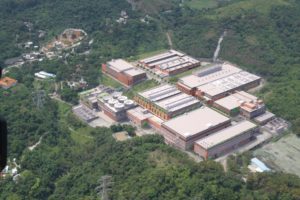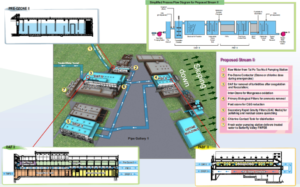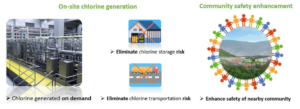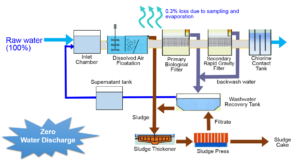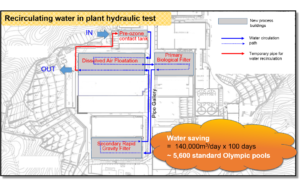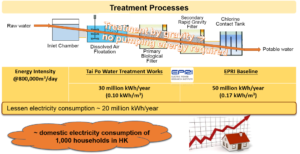Tai Po Water Treatment Works
The Water Supplies Department (WSD) of the Hong Kong Special Administrative Region Government has launched a project to expand Tai Po Water Treatment Works (WTW) to double its existing water treatment capacity to 800 million litres per day for supplying fresh water to Tai Po in New Territories, West and Central Kowloon and the Central and Western Districts of the Hong Kong Island.
In the pursuit of excellence by the engineering team, the Tai Po WTW has integrated innovative and creative engineering features into the existing WTW and developed sustainable solutions in the expansion project.
Overview of Tai Po Water Treatment Works
Stacked Design to Preserve Land Resources
Due to the limited footprint surrounded by hilly terrain, Tai Po WTW adopted compact treatment processes. Different treatment process facilities are stacked up to save space. Under a conventional single-storey design arrangement, the WTW would require a land area of 21 hectares.
The stacked design, on the other land, only occupies 14 hectares, which substantially saves up to 32% of the land area. This innovative idea for preserving land resources was particular valuable in Hong Kong context due to scarcity of land; and for this, the project was awarded with the International Water Association Project Innovation Award 2006.
Stacked process design
Enhancing Safety of Community by On-site Chlorine Generation
By adopting the advanced water treatment ozone technology, the chlorine consumption in Tai Po WTW is reduced by 30%. As chlorine is still required for residual disinfection for the treated water, the WTW would adopt on-site chlorine generation to replace the existing liquid chlorine dosing system to eliminate leakage risk associated with the storage and transport of liquid chlorine.
This technological development greatly reduces the potential hazard of chlorine leakage to nearby community and enhances the compatibility of the WTW with adjacent developments.
On-site Chlorine Generation
Designing for a Water Cherishing Process
Zero Water Discharge
A remarkable feature of the WTW is to achieve “zero water discharge”. All water for backwashing the filters is captured and returned after wash water recovery process to the raw water inlet chamber for re-use.
Distinguished from other WTWs in Hong Kong, Tai Po WTW further reduces the water loss in the sludge by recovering water from the filtrate through the sludge presses. Overall, the water cherishing treatment process attains a very high water conversion efficiency of 99.7%.
Zero Water Discharge Treatment Process
Recycling of Testing Water in Commissioning
Substantial amount of raw water was required for testing and commissioning of the treatment facilities in the expansion of the Tai Po WTW. Five recirculation pumps were purposely constructed to recirculate the water for testing the hydraulic performance of the expansion of the WTW from the outlet to the inlet, without the need to disposing the precious water of around 14 million cubic metre, equivalent to the volume of 5 600 standard size Olympic pools.
Water Recirculation for Testing and Commissioning
Leveraging Building Information Modelling (BIM) Solutions
Awarded with Autodesk HK BIM Awards 2017, Tai Po WTW project adopted BIM technology for the chlorine building throughout its life cycle. Unmanned aerial vehicle will also be used for as-built laser scanning to obviate the need of working at height and hence improved site safety. BIM Augmented Reality training device was also used to enhance training quality provided for the front-line operators.
Adoption of Building Information Modelling
Building an Energy-Efficient Facility
To conserve energy, the treatment process was designed to receive raw water and go through various process systems to the final outlet merely by gravity, without the need of re-pumping to elevate the head. The WTW benchmarked the average energy consumption of other WTWs in US conducted by the US Electric Power Research Institute (ERPI).
Tai Po WTW is 40% more energy efficient than the other WTWs in US according to the ERPI’s statistics. Together with other energy-efficient building services, the total annual saving in energy in the WTW is equivalent to energy consumption of about 1 000 households in Hong Kong.
Water Treatment by Gravity
Tai Po WTW has demonstrated huge efforts in making the best use of resources and technologies and its responsibility towards the environment through various innovative and sustainable measures. Tai Po WTW is a shining example of engineering excellence, sustainability innovation and stewardship.
We have a lot more about Tai Po WTW to share with you. The coming 8th IWA-ASPIRE Conference and Exhibition 2019 from 31 October to 2 November 2019 will undoubtedly make Hong Kong as the focal point of the international water industry. Details of the programme and registration are shown on the ASPIRE website www.iwaaspire2019.org.
We sincerely invite you to come and visit Hong Kong to participate in the IWA-ASPIRE Conference.
The IWA-ASPIRE 2019 has been established in promoting communications and collaborations within the Asia-Pacific region. In addition to the cooperation and collaboration, it is a platform for sharing the best practice, growing in knowledge and strengthening the bonding in the sector. The Conference & Exhibition will be held from 31 October to 2 November 2019 in the Hong Kong Convention and Exhibition Centre. The 3-day Conference and Exhibition plus technical visits and workshops will attract 1 000 participants all over the world.
- Deadline forSubmission of Extended Abstracts: 22 July 2019. More information here.
- Online registration is open. Please register before 31 July 2019 to enjoy the Early-Bird Discount. More information on registration here.
More information: www.iwaaspire2019.org
